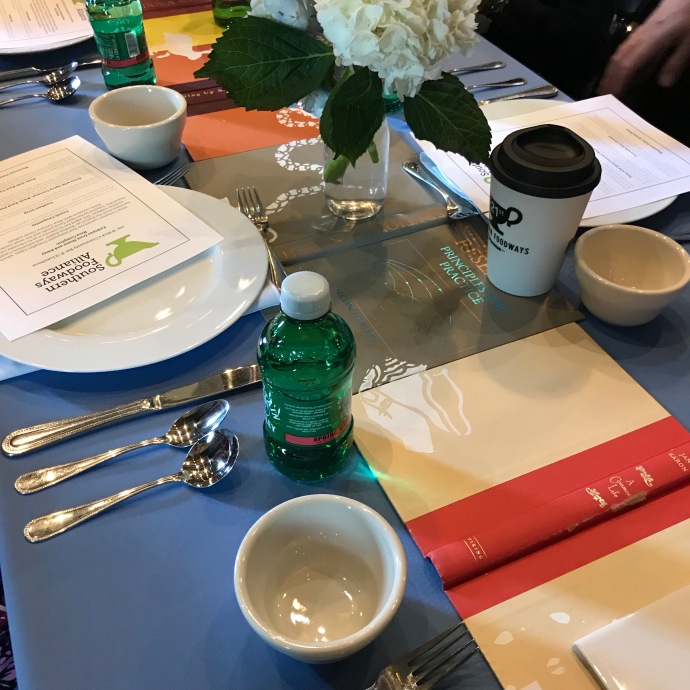(Lunch is a big deal at the Southern Foodways Alliance Symposium. As we get closer to the 2019 event, here’s a look back at a noonday meal from 2018 that truly embodied the spirit of the theme, celebrating the connection between food and literature. And yes, menus are literature.)
It’s no secret among those I’m close to that I’m a collector. Most likely I’ve mentioned it in these pages before. Some might even say that I’m a hoarder, but there’s a vast difference. Number one, you can easily walk around in my house. And number two, I choose to believe the things I collect are valuable and will one day be treasured by my children, or sold immediately upon my departure from this earth. Either way, in my mind it’s a win-win for them.
Among those collections is a file of menus. Note that I said “a” file – as in “one.” Not a file box full, not a closetful. See? Not a hoarder. I do have a small box or two full of food-related memorabilia which may also contain some menus, but generally speaking, it’s a small, manageable collection. Not like the 45,000 plus that the New York Public Library boasts. The Wife would have to give up some purse storage space if mine was that big. Thus, it will never be that big.
One of the most fascinating speakers at this year’s Southern Foodways Alliance Symposium was John Kessler, a former food columnist for the Atlanta Journal-Constitution. The theme of this year’s symposium was “Reading Food: From Menus to Soap Operas to Novels.” His topic was “Menus as Texts.” He showed us how menus have changed over the years and how each told a particular kind of story. It didn’t take long for me to realize my file is not just a collection of dish descriptions, it’s a folder full of memories.
Ordinarily, at each symposium meal we are given a colorful menu card with some amount of detail regarding what’s in each dish. I’m not gonna’ lie – those menus are excellent cheat sheets. With them in hand, I don’t have to ask a lot of questions about what’s in the dish or how it is cooked; everything is there already, documented for posterity. I don’t have to keep a list of ingredients in my pocket-sized notebook, only my reactions to what those ingredients trigger on my tongue.

This year most of the menus were different. At breakfast, for instance, we got the name of the dish, but instead of a description of how the chef’s mother used to make this back in the day, we got a poem or a paragraph from a novel. In most cases, we got more story than a list of groceries, but that makes some sense, considering the theme. At Jim ’N Nick’s Community Bar-B-Q Luncheon on Friday, we got folktales.
The storyteller that day was Nina Compton, the chef at Compere Lapin in New Orleans. Compere Lapin means “Brother Rabbit” in French, and refers to folktales Chef Compton heard as a child in St. Lucia about a mischievous rabbit. Her menus, both at the restaurant and at lunch that day, are inspired by the playfulness of those stories, and reflect a brotherhood of Caribbean and Creole cuisines.
We began with Conch Croquettes. If you’re unfamiliar with conch, it’s only because you didn’t know the name of that enormous seashell sitting on the shelf, the one you can put up to your ear and hear the ocean. As a young man, my folks took us to the Bahamas and I had my first conch fritter, so this was not my first conch rodeo. This, however, was different from the dense tuna croquettes that I know how to make; instead it was tender inside the slightly crunchy batter.

Our next course was Cowheel Soup, a street food in the Caribbean that is supposedly enjoyed by mythical ladies of the evening who actually have cowheel feet. I must confess that I didn’t read the word that carefully at first. I was focused on the soup itself, which reminded me a little of the broth from a good lentil soup, but with chunks of bone floating around. Bones help flavor and can even add thickening to a soup, so that wasn’t so surprising. It was only later that I realized, those were small chunks of cowheel. The heel of a cow. Words have meaning, it seems.

The main dish made me a little nervous at first, given that the word “coconut” was in the description: Pelau with Spicy Coconut, Black-Eyed Peas, and Chicken. My hope was that the coconut would be in the form of milk or cream, without those pesky flakes. Hope fulfilled. A large round skillet was brought to the table, filled with a dense mix of rice and black-eyed peas, the chicken legs fanned out in a circle. Google tells me that traditional pelau has a bit of sugar and a mix of warm spices such as cardamom and cloves, and I did detect a note of sweet which I’m sure was a factor in sending me back to the dish for more. The menu, however, told the story of a soucouyant, a shapeshifting witch in Caribbean folklore that could be caught by heaping rice around the house. It just goes to show that collecting can be useful, as long as you collect the right things.

We finished up with a Pone with Rum Caramel, a dark cake topped with pecans trapped in a thick, rich caramel. Appropriately, the accompanying story was of the Jab Molassie, a devil character whose end came when he fell (or was thrown) into a vat of boiling molasses on a sugar plantation. Would that constitute a sweet ending? Perhaps not for the Jab. But for those of us at lunch that day, it certainly was.

